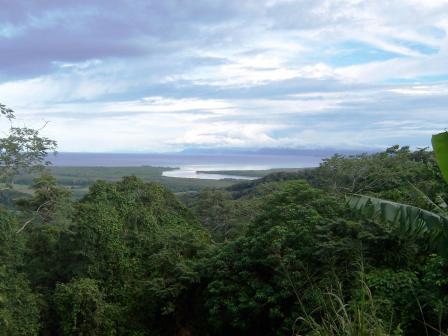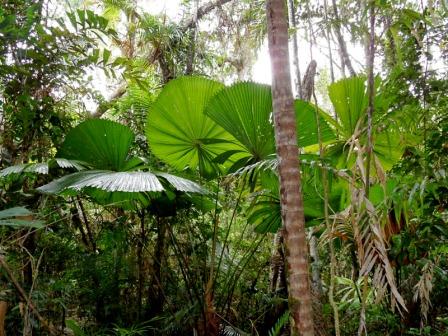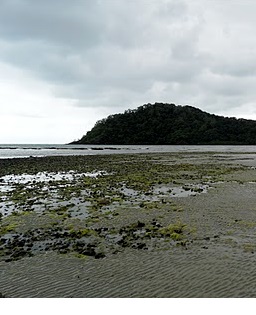Daintree Rainforest & Cape Tribulation

I have had the privilege of visiting the wonderful Daintree Rainforest and Cape Tribulation, which is part of the wet tropics of Queensland World Heritage Site. This area was listed in 1988 by UNESCO in recognition of its universal natural values, highlighted by the rainforest and its diverse and at times unique fauna and flora.
The Daintree Rainforest and Cape Tribulation are situated approximately 140 kms north of Cairns, in Queensland. Measuring roughly 2,600 kms (1,000 square miles), the Daintree is the largest continuous area of topical rainforest on the Australian continent. It is also unique in that the rainforest grows right down to the edge of the ocean.
Taking a walk through this incredible environment, one is immediately amazed at the beautiful earthy smell. It’s not an offensive smell, but one of pure moist soil. The plants of the Daintree Rainforest are very diverse with some ancient plants believed to be the earliest land plants found anywhere in the world. There are seven ancient families of ferns and 12 primitive angiosperm (flowering plant) families to name but a few. We were constantly amazed at the size of the leaves of some of these species.
The Daintree Rainforest contains over 30% of the frog, reptile and marsupial species in Australia and 65% of Australia’s bat and butterfly species. Amazingly, 18% of bird species in Australia can be found in this one rainforest area. A large part of this rainforest is protected by the Daintree National Park and is drained by the Daintree River. The river is a notorious home to the crocodile and fatalities have occurred since the area was opened to tourists.
All roads north of the river have been built through lush rainforest areas, and have been designed to minimize impacts on this extremely ancient ecosystem. The Daintree region which includes the rainforests and the Daintree River system is home to a number of rare and endangered species including the Southern Cassowary and Bennett’s Tree Kangaroo.
It is considered by experts that the Daintree rainforests is over one 135 million years old – and is the oldest in the world. Incredibly, 430 species of birds live among the trees including 13 species that are found nowhere else in the world.
During out day tour to the Daintree Rainforest and National Park, we traveled to Cape Tribulation which is part of the Wet Tropics World Heritage area. Originally named by Captain James Cook on his famous 1770 tour of the southern hemisphere, after the Endeavour struck part of the Great Barrier Reef and was disabled for a time.
The Cape has had a troubled history, particularly in reference to efforts made in conserving the area and keeping it free of anything that might cause its downfall. In 1983 a blockade of the Bloomfield track occurred when protestors tried to stop bulldozers from making a road through the Daintree Rainforest to Cape Tribulation. It was owing to the wild scenes and persistent protesting over many months that finally made the federal and state governments realize the incredible value of this ancient rainforest area and that it was worthy of conservation.
I can fully recommend a tour of the Daintree Rainforest and Cape Tribulation area. There are many forms of tours available, and lots of diverse accommodation is available for those who wish to spend a few days in this pristine rainforest region.
The Daintree Rainforest and Cape Tribulation are situated approximately 140 kms north of Cairns, in Queensland. Measuring roughly 2,600 kms (1,000 square miles), the Daintree is the largest continuous area of topical rainforest on the Australian continent. It is also unique in that the rainforest grows right down to the edge of the ocean.
Taking a walk through this incredible environment, one is immediately amazed at the beautiful earthy smell. It’s not an offensive smell, but one of pure moist soil. The plants of the Daintree Rainforest are very diverse with some ancient plants believed to be the earliest land plants found anywhere in the world. There are seven ancient families of ferns and 12 primitive angiosperm (flowering plant) families to name but a few. We were constantly amazed at the size of the leaves of some of these species.
The Daintree Rainforest contains over 30% of the frog, reptile and marsupial species in Australia and 65% of Australia’s bat and butterfly species. Amazingly, 18% of bird species in Australia can be found in this one rainforest area. A large part of this rainforest is protected by the Daintree National Park and is drained by the Daintree River. The river is a notorious home to the crocodile and fatalities have occurred since the area was opened to tourists.
All roads north of the river have been built through lush rainforest areas, and have been designed to minimize impacts on this extremely ancient ecosystem. The Daintree region which includes the rainforests and the Daintree River system is home to a number of rare and endangered species including the Southern Cassowary and Bennett’s Tree Kangaroo.
It is considered by experts that the Daintree rainforests is over one 135 million years old – and is the oldest in the world. Incredibly, 430 species of birds live among the trees including 13 species that are found nowhere else in the world.
During out day tour to the Daintree Rainforest and National Park, we traveled to Cape Tribulation which is part of the Wet Tropics World Heritage area. Originally named by Captain James Cook on his famous 1770 tour of the southern hemisphere, after the Endeavour struck part of the Great Barrier Reef and was disabled for a time.
The Cape has had a troubled history, particularly in reference to efforts made in conserving the area and keeping it free of anything that might cause its downfall. In 1983 a blockade of the Bloomfield track occurred when protestors tried to stop bulldozers from making a road through the Daintree Rainforest to Cape Tribulation. It was owing to the wild scenes and persistent protesting over many months that finally made the federal and state governments realize the incredible value of this ancient rainforest area and that it was worthy of conservation.
I can fully recommend a tour of the Daintree Rainforest and Cape Tribulation area. There are many forms of tours available, and lots of diverse accommodation is available for those who wish to spend a few days in this pristine rainforest region.

Related Articles
Editor's Picks Articles
Top Ten Articles
Previous Features
Site Map
Content copyright © 2023 by Judie Bellingham. All rights reserved.
This content was written by Judie Bellingham. If you wish to use this content in any manner, you need written permission. Contact Judie Bellingham for details.







